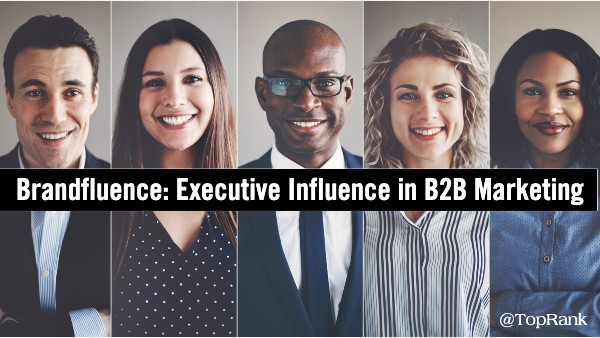
If there was one thing 2020 showed us in the B2B marketing world, it was the growing importance of influence in all aspects of the customer lifecycle from awareness to advocacy. People want to connect with other people, not some faceless brand.
The good news is that smart B2B marketers are putting a face to their brands through employee advocacy programs and building the visibility and influence of their key executives. But how should B2B brands approach the task of growing their brandfluence? At TopRank Marketing we deal in the business of influence and content in the B2B marketing world every day and here are 3 key trends we’re seeing drive an increase in focus on building executive influence:
Building Credibility of Key B2B Executives. One relatively new SaaS platform wanted to build thought leadership and credibility of the CEO to assist brand awareness. For another large B2B tech brand, key executives engaged with industry analysts on the LinkedIn platform inspiring the analyst to organically invite the tech executive to collaborate on content.
Humanize the B2B Brand. Elevating professional credibility through industry thought leadership is complemented by sharing of personal perspectives to show care, empathy and to develop more personal relationships with the audience. With brand communications less trusted, people to people engagement is more valuable than ever. A large enterprise tech brand executive has been able to attract and warm a new network by sharing a combination of industry thought leadership content mixed with snapshots of personal life.
Accelerate the B2B Sales Pipeline. Many key executives may not work in sales directly, but they do participate in sales conversations from time to time. Social engagement with prospects along with publishing credible thought leadership content warms prospects for conversations that lead to conversion. A basic example of this is, before an important sales meeting, one large B2B brand will often instigate engagement between key executives mapped to important prospect contacts.
Executive Thought Leadership in Action on LinkedIn
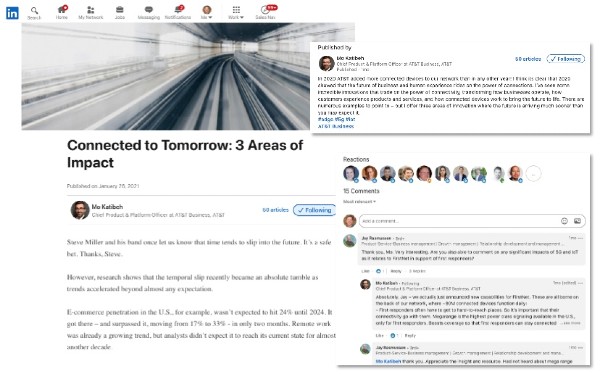
Scrolling through my LinkedIn feed when writing this post, I see Mo Katibeh, Chief Product and Platform Officer at AT&T Business. Mo is a key executive in a position to influence perceptions of AT&T Business solutions amongst key decision makers and decision influencers. He publishes LinkedIn pulse articles driving conversations with people influential in the space. He also shares key messages in the feed including brand social cause issues.
Additionally, he also partners with industry influencers like Tamara McCleary on thought leadership content which gives him more credibility by association and introduces his expertise to Tamara’s substantial and relevant audience.
Build Executive Influence Through Influencer Collaborations
In a digital first B2B world with increased competition, creating influence through thought leadership content alone isn’t enough. B2B brands have an opportunity to optimize their thought leadership and executive influence efforts through thoughtful alignment of key executives with industry influencers who have the attention of customers on the topics of interest to the brand.
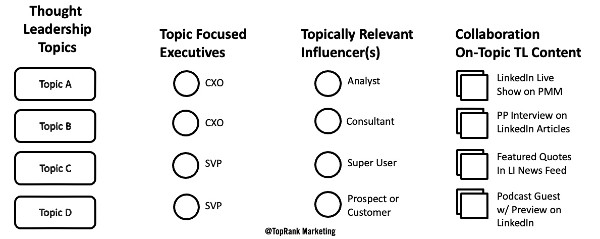
The diagram above is an oversimplification, but once thought leadership topics are identified, the corresponding executives for those topics can be assigned and mapped to relevant industry influencers who have authority on those topics. Then a collaboration opportunity can be created to engage the executive focused on a given topic with an industry influencer for that very same topic. The resulting collaboration produces content that is even more valuable to the audience because it is trusted, it has reach, it is authentic and is focused.
Many executives who engage in these influencer thought leadership collaborations develop relationships with the influencers involved. Peer engagement can be difficult for busy executives and connecting with others at the top of their game can be mutually valuable and energizing for all involved.
SAP’s Thought Leadership Platform Featuring Brand Executives and Industry Influencers
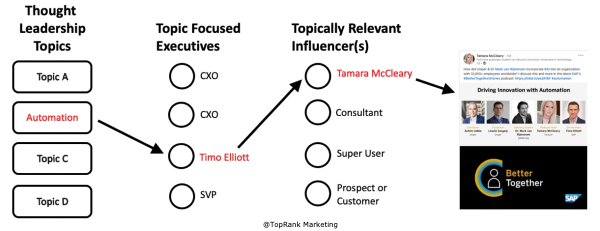
Collaborations between executives and industry influencers can take many forms. In this example, SAP created a thought leadership content platform in the form of pre and post event blog posts, a podcast and LinkedIn Live show #BetterTogetherStories. This thought leadership content features industry tech influencers like Tamara McCleary along with SAP executives as well as other industry experts, customers, and partners to talk about specific topics at the intersection of what customers need to be thinking about and where SAPs expertise can be a solution.
External influencers like Tamara and internal influencers like Timo bring credibility and expertise to the conversation with SAP executives and customers that creates value for all guests as does the exposure of the podcast to their audiences. SAP executive influence (brandfluence) is boosted by being associated with respected influencers AND as part of thought leadership content that is valuable to customers.
In our practice working with B2B brands, we’ve developed a process for building brandfluence for B2B executives through social engagement and thought leadership content collaborations with industry influencers:
- Step 1 – Research and develop a topic and messaging strategy. Map relevant influencers to trending topic conversations and executives.
- Step 2 – Build relationships with influencers between executives and influencers following social nurturing and engagement best practices
- Step 3 – Invite influencers and executives to collaborate on thought leadership content
- Step 4 – Extend the reach of thought leadership content through combined brand, executive and influencer amplification
- Step 5 – Evaluate and report KPIs. Compare performance to benchmarks (content, influencer and executive performance) and optimize for improvement
Measures of Success for B2B Executive Influence and Thought Leadership
As with all marketing activities, measures of success correspond with the goals of your efforts. Some of the KPIs we’ve seen B2B brands focus on for building executive and brand influence through thought leadership and influencer content include:
- Increased SOV with the right influencers on the right topics, reaching the right audience
- Scaling the influencer community from not engaged to an active brand community member
- Genuine engagement and collaboration between influencers and B2B Brand executives
- Reach & Engagement on social posts and thought leadership content
- Increased connections with targeted influencers and target accounts
Without question there are new and exciting opportunities for B2B executives to advance brand thought leadership by building their own – brandfluence. But competition is increasing as B2B moves more marketing and PR resources to digital channels. Partnering with industry influencers on thought leadership content is an effective way for B2B executives to build their own influence while creating relationships with the respected voices that can drive reach, engagement and impact across the entire customer lifecycle.
If you’d like to learn more about building B2B thought leadership with brand executives, be sure to tune in to the March 31st Edition of LinkedIn’s Live with Marketers: The Business of Executive Thought Leadership featuring Alex Rynne and Amber Naslund from LinkedIn and myself as we cover:
- What a compelling executive presence can do for your business
- Examples of effective thought leadership on LinkedIn
- How to measure your thought leadership efforts
- How to create a compelling and engaging profile
- How to integrate brand, executives and corporate communication
And more. Get more info and sign up here.

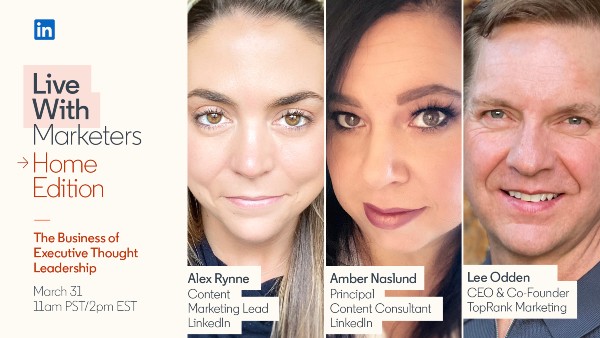
Comments are Closed